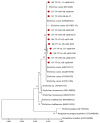Molecular Survey and Genetic Analysis of Ehrlichia canis in Rhipicephalus sanguineus Ticks Infesting Dogs in Northern Taiwan
- PMID: 40572260
- PMCID: PMC12196287
- DOI: 10.3390/microorganisms13061372
Molecular Survey and Genetic Analysis of Ehrlichia canis in Rhipicephalus sanguineus Ticks Infesting Dogs in Northern Taiwan
Abstract
Ehrlichia canis is a tick-transmitted zoonotic pathogen in dogs. We conducted a molecular survey for screening of E. canis infection in Rhipicephalus sanguineus ticks infesting dogs and identified its genetic identity in Taiwan. A total of 1195 R. sanguineus ticks were collected and examined for Ehrlichia infection by nested-PCR assay targeting the 16S ribosomal RNA (rRNA) gene. In general, Ehrlichia infection was detected in 1.5% of examined ticks, and was detected in nymph, male and female stages with infection rates of 0.6%, 1.31% and 2.76%, respectively. The highest monthly prevalence was observed in August with an infection rate of 5.91%. Genetic identity was analyzed by comparing the 16S rRNA gene sequences obtained from 11 Taiwan strains and 15 other strains representing five genospecies of Ehrlichia spp., including two outgroups (Anaplasma phagocytophilum and Rickettsia rickettsii). Results revealed that all Taiwan strains were genetically affiliated to the same clade within various E. canis strains documented in GenBank with a high sequence similarity (99.7-100%) and that they can be clearly distinguished from other genospecies of Ehrlichia. This study provides the first evidence of E. canis identified in R. sanguineus ticks and highlights the potential threat for human infections in Taiwan.
Keywords: Ehrlichia canis; Rhipicephalus sanguineus; Taiwan; tick; zoonosis.
Conflict of interest statement
The authors declare no conflicts of interest.
Figures




Similar articles
-
Parasitological and molecular detection of Hepatozoon canis in Rhipicephalus sanguineus and Rhipicephalus turanicus in Khorasan Razavi province, Iran.J Parasit Dis. 2025 Jun;49(2):313-319. doi: 10.1007/s12639-024-01760-5. Epub 2024 Nov 6. J Parasit Dis. 2025. PMID: 40458491
-
Distribution of Rhipicephalus sanguineus and Heamaphysalis elliptica dog ticks and pathogens they are carrying: A systematic review.Vet Parasitol Reg Stud Reports. 2024 Jan;47:100969. doi: 10.1016/j.vprsr.2023.100969. Epub 2023 Dec 12. Vet Parasitol Reg Stud Reports. 2024. PMID: 38199685
-
Prevalence of tick-borne pathogens in Rhipicephalus species infesting domestic animals in Africa: A systematic review and meta-analysis.Acta Trop. 2023 Oct;246:106994. doi: 10.1016/j.actatropica.2023.106994. Epub 2023 Jul 27. Acta Trop. 2023. PMID: 37516420
-
Molecular Screening and Genetic Identification of Anaplasma platys in Brown Dog Tick (Rhipicephalus sanguineus s. l.) Infested on Stray Dogs in Taiwan.Microorganisms. 2024 Aug 28;12(9):1779. doi: 10.3390/microorganisms12091779. Microorganisms. 2024. PMID: 39338454 Free PMC article.
-
Genotyping of Ehrlichia canis TRP36 isolated from ticks and dogs in Iran.Vet Microbiol. 2025 Aug;307:110592. doi: 10.1016/j.vetmic.2025.110592. Epub 2025 Jun 10. Vet Microbiol. 2025. PMID: 40516375
References
-
- Donatien A., Lestoquard F. Existence en Algerie d’une Rickettsia du chien. Bull. Soc. Pathol. Exot. 1935;28:418–419.
-
- Skotarczak B. Canine ehrlichiosis. Ann. Agric. Environ. Med. 2003;10:137–141. - PubMed
LinkOut - more resources
Full Text Sources
Miscellaneous

